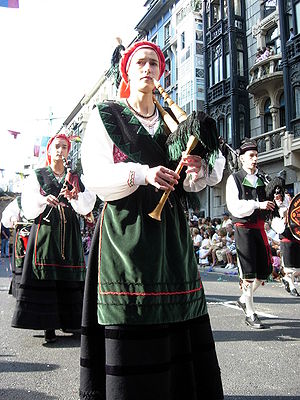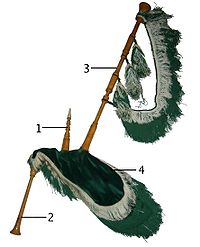
Gaita asturiana
Encyclopedia

Asturias
The Principality of Asturias is an autonomous community of the Kingdom of Spain, coextensive with the former Kingdom of Asturias in the Middle Ages...
and parts of Cantabria
Cantabria
Cantabria is a Spanish historical region and autonomous community with Santander as its capital city. It is bordered on the east by the Basque Autonomous Community , on the south by Castile and León , on the west by the Principality of Asturias, and on the north by the Cantabrian Sea.Cantabria...
on the northern coast of Spain
Spain
Spain , officially the Kingdom of Spain languages]] under the European Charter for Regional or Minority Languages. In each of these, Spain's official name is as follows:;;;;;;), is a country and member state of the European Union located in southwestern Europe on the Iberian Peninsula...
.
Differences from other Iberian gaitas
- The gaita asturiana is of longer size than the Galician gaitaGalician gaitaThe gaita or gaita de foles is a traditional bagpipe of Galicia, Asturias and northern Portugal.The name gaita is used in Galician and Spanishlanguages as a generic term for "bagpipe"...
of the same key; that is to say, its pipes are of longer dimensions. The reed of the chanter (payuela) is of smaller size than the gallega reed. Compared to the gallega, the finger holes are distributed differently, making it easier to extend to the 3rd of the second octave with a simple increase in air pressure on the bag (fuelle), a method known as requintar.
- In the neighboring province of CantabriaCantabriaCantabria is a Spanish historical region and autonomous community with Santander as its capital city. It is bordered on the east by the Basque Autonomous Community , on the south by Castile and León , on the west by the Principality of Asturias, and on the north by the Cantabrian Sea.Cantabria...
the gaita asturiana is also called astur-cántabra or cántabra, though in construction it is identical.
Attestation
The first evidence for the existence of the gaita asturiana dates back to the 13th century, as a piper can be seen carved into the capital of the church of Santa María de Villaviciosa. Further evidence includes an illumination of a rabbit playing the gaita in the 14th century text Llibru la regla colorada. An early carving of a wild boar playing the pipes may be seen at the Cathedral of Oviedo.History and evolution

The gaita asturiana today
Currently, the gaita asturiana is constructed in a wider array of keys and types, anywhere from B to as high as E. Also, refinement of the chanter construction has made it possible to play as high as the tonic in the third octave. Further, the ability to hit chromatic notes has increased, turning the chanter from a completely diatonic instrument to a nearly fully chromatic one. The addition of auxiliary holes has also increased. As a further sign of modernisation, keys have been added to some variants to extend range and chromatic ability.Famous gaiteros asturianos
In the history of the gaita, there have been numerous notable players. It is necessary to begin with the legendary Gaiteru Llibardón, author of the first recording of the gaita. Throughout the 20th century there have been other famous gaiteros, such as José Remis Vega (capilla) and his son José Remis Ovalle, a reference for today's gaita interpretations.José Ángel Hevia Velasco, known professionally as Hevia
Hevia
José Ángel Hevia Velasco, known professionally as Hevia , is a Spaniard bagpiper – specifically, an Asturian gaita player. He commonly performs with his sister, Maria José, on drums...
(born 1967 in Villaviciosa, Asturias
Villaviciosa, Asturias
Villaviciosa is a town and in the autonomous community of Asturias, Spain. It is situated on the central eastern coastline, and borders the Asturian municipalities of Gijón and Siero to the west, Sariego, Nava, Cabranes and Piloña to the south and to Colunga to the east. The total area is 271 km²...
). Hevia is known for helping invent a special brand of MIDI electronic bagpipes, which he is often seen playing live. He commonly performs with his sister, Maria José
María José
María José is a singer, ballet and flamenco dancer, and athlete, she also has a B.A. in Communications. She is well known and established within the music industry since she was part of a very popular pop-singing band in Mexico, Kabah, from the mid to late 90's.Her first experience on stage was at...
, on drums. In 1992 he was awarded first prize for solo bagpipes at the Festival Interceltique de Lorient, Brittany.
External links
- GaitaForum.com, a discussion forum for gaitas

